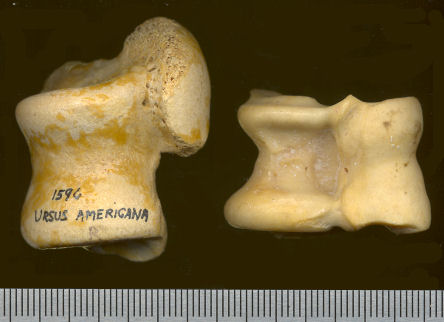Class Mammalia
Order Artiodactyla
Suiformes—Peccaries // Tylopoda—Camels // Ruminantia—Ruminants
 Artiodactyls are herbivores characterized by having the foot axis pass between
the third and fourth digits (instead of through the third digit as in the
perissodactyls) and having a "double-pulley" astragalus.
Artiodactyls are herbivores characterized by having the foot axis pass between
the third and fourth digits (instead of through the third digit as in the
perissodactyls) and having a "double-pulley" astragalus.
Fig. 1. Astragalus of Ursus americanus (left) and Ovis canadensis illustrating the specialized artiodactyl astragalus compared to that of a typical non-artiodactyl. Metric scale.
The artiodactyls form an immense group of herbivores that dominate most terrestrial habitats, challenged only by the rodents. The historic distribution is worldwide except for Antarctica, Australia, and oceanic islands. Major taxa other than those listed in the heading include the Old World Tragulidae (chevrotains), Hippopotamidae (Hippopotamuses), Giraffidae (giraffes), and Suidae (pigs).
The Suiformes, Tylopoda, and Ruminantia often are treated as suborders of the Artiodactyla, a course followed here. Looking at North America only, the Suiformes includes living and extinct peccaries; the Tylopoda includes the extinct camels and llamas; and the Ruminantia includes living and extinct species of deer, bison, sheep, mountain goats, muskoxen, and pronghorns.
Last Update: 5 Dec 2008